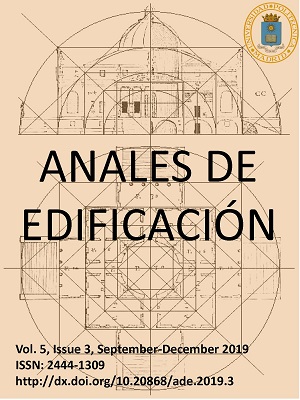Prototipo de Cubierta Vegetal Autosostenible para la mejora de la Eficiencia Energética = Self-Sustaining Green Roof Prototype for the Improvement of Energy Efficiency
DOI:
https://doi.org/10.20868/ade.2019.4368Palabras clave:
cubierta vegetal, eficiencia energética, monitorización, Arduino, energía solar fotovoltaica, riego automático, green roof, energy efficiency, monitoring, photovoltaic solar energy, automatic irrigation.Resumen
Desde comienzos del siglo XXI se ha producido una creciente interiorización por parte de los técnicos del sector de la construcción acerca de las consecuencias que el modelo energético actual tiene sobre el equilibrio medioambiental. Las cubiertas vegetales ofrecen múltiples beneficios tanto sociales, como económicos, ya que, entre otras ventajas, regulan la temperatura, purifican el aire y ayudan a promover la biodiversidad en las ciudades. Esta tipología de elementos constructivos forma parte del movimiento que se conoce por el nombre de arquitectura bioclimática. En este trabajo se propone un nuevo sistema de bajo coste basado en la tecnología Arduino, que permite la monitorización y el riego automático de una cubierta vegetal. Gracias a la utilización de este tipo de instalaciones se puede realizar un seguimiento total del ahorro energético conseguido al implantar este tipo de cubiertas en los edificios, reaprovechar el agua de lluvia para el llenado del depósito de riego y alimentar el bombeo de agua mediante energía solar fotovoltaica convirtiéndolo en un modelo sostenible.Abstract
Since the beginning of the 21st century, there has been a growing internalization by the technicians of the construction sector about the consequences that the current energy model has on the environmental balance. Green Roofs offer multiple social and economic benefits, among other advantages, they regulate the temperature, purify the air and help promote biodiversity in cities. This typology of constructive elements is part of the movement that is known by the name of bioclimatic architecture. This work proposes a new low-cost system based on Arduino technology, which allows the monitoring and automatic irrigation of a green roof. Thanks to the use of this type of facility, you can track the energy savings achieved by implementing this type of roofs in the buildings, reuse the rainwater for filling the irrigation tank and feed the water pumping by solar energy photovoltaic turning it into a sustainable model.
Descargas
Referencias
Baik, J., Kwak, K., Park, S., Ryu, Y. (2012). Effects of building roof greening on air quality in street canyons. Atmospheric Environment, 61, 48-55.
Diaz, J. (2018). Desarrollo de un prototipo mecatrónico de seguidor solar parabólico para la edificación. Tesis Doctoral, Universidad Politécnica de Madrid.
Fioretti, R., Palla, A., Lanza, L.G., Principi, P. (2010). Green roof energy and water related performance in the Mediterranean climate. Building and Environment, 45(8), 1890-1904.
Getter, K.L., Rowe, D.B., Andresen, J.A., Wichman, I. (2011). Seasonal heat flux properties of an extensive green roof in a Midwestern U.S. climate. Energy and Buildings, 43(12), 3548-3557.
Lazzarin, R.M., Castelloti, F., Busatto, F. (2005). Experimental measurements and numerical modelling of a green roof. Energy and Buildings, 37 (12), 1260-1267.
Méndez. J.M., Cuervo, R. (2008). Energía Solar Fotovoltaica - 3ªEdición-. Editorial Fundación CONFEMETAL, ISBN: 978-84-96743-45-8.
Ministerio de Economía. (2014). Guía rápida Horizonte 2020. Centro para el Desarrollo Tecnológico Industrial (CDTI), Guía elaborada por la División de Programas de la Unión Europea del CDTI en colaboración con el Ministerio de Economía y Competitividad (MINECO) y la Oficina Europea (FECYT-MINECO)
Ministerio de Fomento. (2019). Código Técnico de Edificación. Documento Básico -Salubridad-. 20 diciembre 2019.
Morón, C.; Diaz, J.P., Ferrández, D., Ramos, M.P. (2016). Mechatronic Prototype of Parabolic Solar Tracker. Sensors 2016, 16(6), 882.
Morón, C. Saiz, P. Ferrández, D. Felices, R. (2018). Comparative Analysis of Infrared Thermography and CFD Modelling for Assessing the Thermal Performance of Buildings. Energies (Q2), 11(3), 638.
Oberndorfer, E., Lundholm, J., Bass, B., Coffman, R.R., Doshi, H., Dunnett, N., Gaffin, S., Koehler, M., Liu, K.K.Y. and Rowe, B. (2007). Green roofs as urban ecosystems: ecological structures, functions, and services. Bioscience 57 (10), 823–833.
Sailor. D.J. (2008). A green roof model for building energy simulation programs. Energy and Buildings, 40(8), 1466- 1478.
Sanchez Paradela, M.L. (2010). Técnicas de construcción convencionales y avanzadas. Fachadas y Cubiertas. Departamento de Construcción y Tecnología Arquitectónicas. E.T.S. Arquitectura. ISBN: 978-84- 936485-6-5.
Scherva, A.; Sailor, D.J., Rosenstiel, T., Wamser, C. (2011). Modeling impacts of roof reflectivity integrated photovoltaic panels and green roof systems on sensible heat flux into the urban environment. Building and Environment, 46(12), 2542-2551.
Taberes, P.C., Srebric, J. (2012). A heat transfer model for assessment of plant-based roofing systems in summer conditions. Building and Environment, 49, 310-323. Vega, G. (2018). Optimización energética y ambiental de sistemas fotovoltaicos para su integración en la edificación. Tesis Doctoral, Universidad Politécnica de Madrid.
Wong, N.H., Chen, Y., Leng, C., Sia, A. (2003). Investigation of thermal benefits of rooftop garden in the tropical environment. Building and Environment, 38 (2), 261-270.
Descargas
Publicado
Número
Sección
Licencia
1. Los autores conservan los derechos de autor y garantizan a la revista el derecho de una Licencia Creative Commons Atribución - Nocomercial 4.0 Internacional que permite a otros compartir el trabajo con un reconocimiento de la autoría y uso no comercial.
2. Los autores pueden establecer por separado acuerdos adicionales para la distribución no exclusiva de la versión de la obra publicada en la revista (por ejemplo, situarlo en un repositorio institucional o publicarlo en un libro).
Salvo indicación contraria, todos los contenidos de la edición electrónica se distribuyen bajo una licencia de uso y distribución “Creative Commons"












